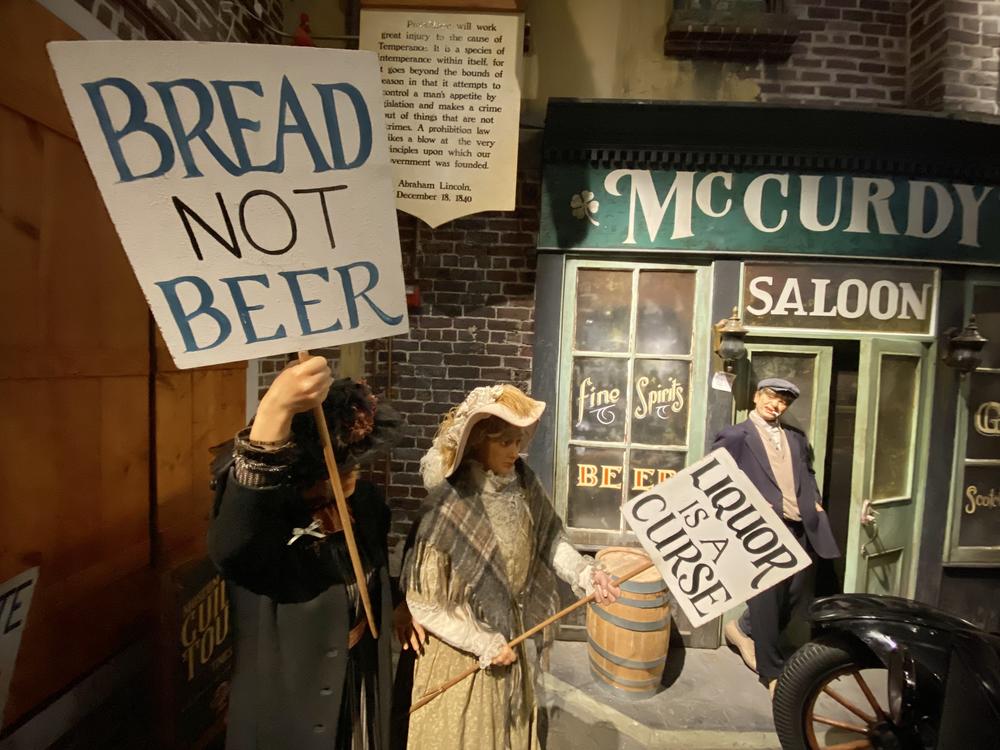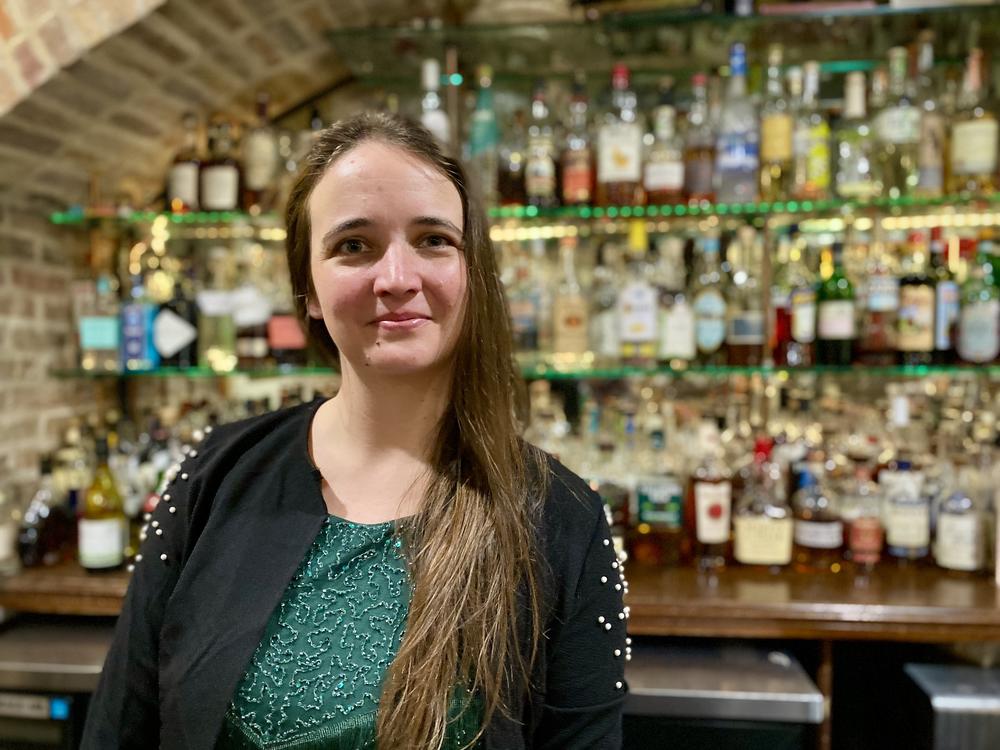
Caption
A model display of Prohibition-era temperance protesters at the American Prohibition Museum in Savannah.
Credit: Benjamin Payne / GPB News
LISTEN: GPB's Benjamin Payne reports from Savannah on how the decline of alcohol consumption is playing out for the party city's bustling tourism economy.

A model display of Prohibition-era temperance protesters at the American Prohibition Museum in Savannah.
Nicole Price reaches for a stainless steel shaker behind the bar at the American Prohibition Museum in downtown Savannah
It's a Sunday, when the local liquor ordinance prohibits most bars — even this "speakeasy" — from serving alcohol. But that's no problem for Price, as she shakes a mixed drink, the metallic rattle of ice cubes punctuating her handiwork.
"We like to do a double-strain here, to make sure that we're not over-diluting," she says, dressed in a flapper-style dress, after shaking the mixture for some 10 seconds. "Get all those little ice chips out of there — and just like that, you've got a mocktail."
Straining the concoction into a coupe glass, Price finishes preparing a Brown Derby mocktail, which she describes as a "classic sour-build" drink: one part sweet (honey syrup), one part sour (grapefruit juice) and two parts Lyre's American Malt, a non-alcoholic spirit branded as an "homage" to Bourbon.
"It's like 'hair of the dog' — but without the hair," Price quips.
As Americans — particularly young adults — increasingly turn away from alcohol, Savannah's identity as a tourism destination may be reaching an inflection point. This cultural change coincides with growing awareness of alcohol's health risks, prompting questions about how the city's $6 billion tourism economy might adapt.
"No amount of alcohol has a health benefit," said Dr. Sharon Bergquist, a professor of medicine at Emory University and researcher in stress and preventative care. "Even moderate consumption is enough to lead to various cancers" for some people, she said, including those of the stomach, colon, and breasts, among other types.
Bergquist, whose forthcoming book The Stress Paradox explores how certain beneficial stressors (of which alcohol is not one) promote longevity, added that many casual drinkers underestimate their own risks, in part because they downplay their own consumption by comparing it to "problem" drinkers.
"A lot of people think that if I'm just socially drinking one drink a night, then all of the warnings and concerns of alcohol and addiction and health happen in people who are heavy users," she said. "I think people look at it very broadly as, 'Alcohol is not good for you,' but not so much break it down into its role in cancer."
New federal dietary guidelines are set to be issued later this year by the Department of Agriculture and the Department of Health and Human Services — informing public health policy and perceptions through 2030 — creating what Bergquist sees as an opportunity for public health policy to better reflect modern scientific understanding.
"The current ones, just to recap, say that for women you can have up to one drink a night and for men up to two drinks a night," she explained. "The guidelines do say that avoidance is better, but it does consider that amount within the dietary guidelines."
What researchers now know, Bergquist said, "and what will hopefully be reflected in the new guidelines, is that even that amount within the current guidelines is enough to cause some of the carcinogenic effects that we're seeing."
This follows former U.S. Surgeon General Vivek Murthy's recent advisory on alcohol, published in January, which declared the substance to be the third-leading preventable cause of cancer.
"That has definitely made an impact on people's consumption," said Georgia Southern University business professor Charles Marvil, who teaches food and beverage operations as part of the school's hospitality certificate program.
Although Congress didn't adopt Murthy's recommendation to require cancer risk labels on alcoholic beverages, his statements nevertheless generated national headlines and heightened public awareness. (The Surgeon General's office currently remains vacant, as the Senate has yet to confirm President Donald Trump's nomination of Dr. Janette Nesheiwat.)
Amid shifting public perceptions around alcohol, tourism leaders are expressing confidence that the Hostess City of the South's popular appeal extends well beyond its bar scene.
"Our tourism community is not based on alcohol," said Michael Owens, president and CEO of the Tourism Leadership Council, a trade group representing businesses in Savannah's tourism sector. "Our tourism community is based on our history, our architecture, the aesthetics of Savannah. That's really the bread and butter of our visitors."
Owens distinguished between visitors and locals, noting that "our night-time economy — that's really a lot more locals and students than it is our visitors."
He recounts conversations with local bar owners, who report establishments remain busy despite decreased alcohol consumption.
"'I'm still packed,'" Owens recalled one saying recently. "'They're coming to see the band. They're coming to dance and they're coming to socialize, but they're not drinking.' FOMO is still there — fear of missing out."
Owens also noted the rising popularity of substances such as hemp-infused gummies, which he said that some patrons are increasingly bringing to bars to consume instead of alcohol.
For businesses, the shift toward non-alcoholic options presents opportunities rather than just challenges.
"Mocktails are very profitable," Marvil said. "I've seen them on menus as expensive as any alcoholic drink. But the ingredients that go into them are generally juices and other types of flavoring agents don't tend to have super high costs."
This, he said, creates the potential for mocktail profit margins as high as their alcoholic counterparts — if not higher.
Alcoholic beverages, according to Marvil, typically cost restaurants and bars 15% to 30% of what they charge the customer, depending on whether the drink is a distilled spirit, beer or wine. Mocktails, on the other hand, cost proprietors 17% to 24% of the price tag on the menu.
Marvil also sees the shift in drinking habits as part of a broader post-pandemic transformation.
"COVID was a big shift in a lot of people's way of dealing with drinking," he said. "Initially, everybody stayed at home because they had to. Consumption of alcohol spiked really hard. But then after a period of time, there was this reaction to this binge consumption where people started to take a step back."
He compares current alcohol awareness to historical revelations about smoking, but with a critical difference: "People aren't going to drop off drinking as quickly as they dropped off smoking because there is an upside from a social standpoint."
Back at the American Prohibition Museum's speakeasy, Price has witnessed the transformation of non-alcoholic alternatives firsthand.
"Mocktails have evolved from just being essentially juice to actually having a little bit more build," Price said. "There are different companies making things that are closer to how actual alcohol tastes."
Sophisticated flavor profiles — not just alcoholic content — define quality cocktails, she said: "There's more to a cocktail than just the alcohol. They're built very specifically to have these flavors that are very balanced."

American Prohibition Museum bar manager Nicole Price
Behind the newfound focus on flavor, Price sees a generational shift in attitudes toward alcohol itself.
"I think people are honestly thinking more about the long run," she said. "Rather than just binge-drinking, which was the culture when I was younger — like when I was 21 — people are recognizing that you don't need to be drinking that heavily."
And so, the days may be numbered for the old joke in the Hostess City that Savannah is a drinking town with a history problem.